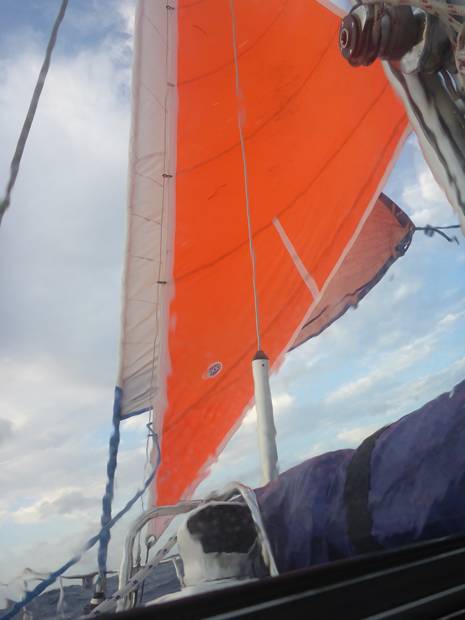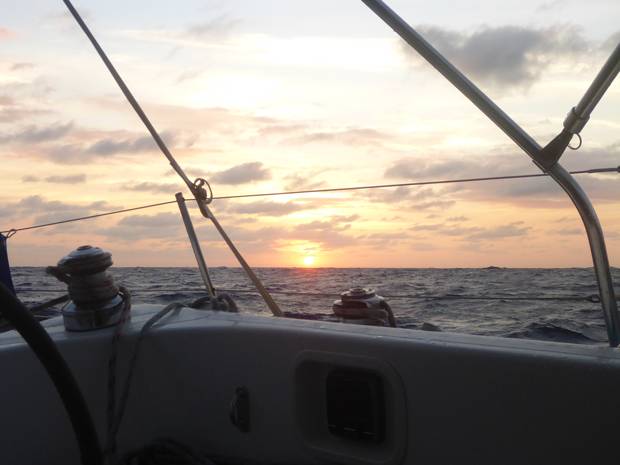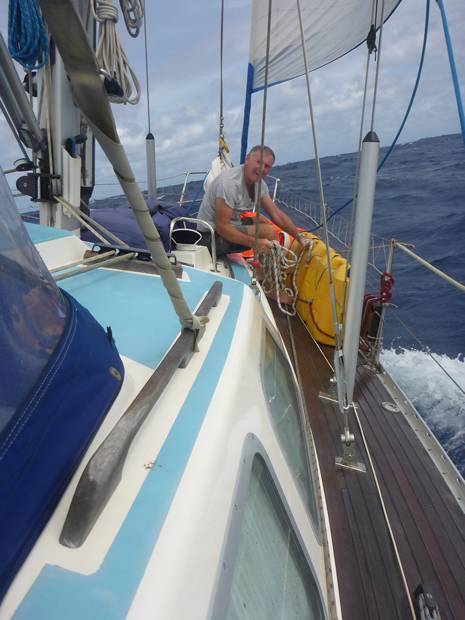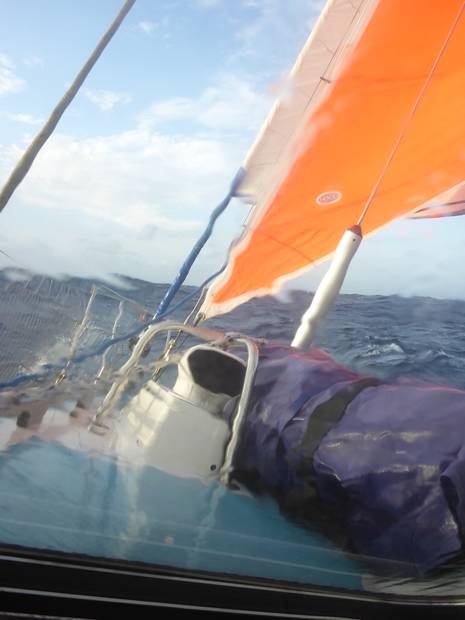A Perfect wind for our Voyage

|
The Perfect Wind For Our Voyage South 18:20.41S 178:18.53E Zoonie crisped along at 6.5 knots with the wind 60’ from her port bow on a course just west of south, 212’ enabling us to sail between Beqa and Kadavu Islands. The wind was a generous 18 – 20 knots and the bow wave washed the very muddy anchor clean in no time. Lisa had waved ‘bye’ as we left the anchorage on October 13th and fearless surfers enjoyed riding the steep waves as they broke on the seaward wide of the reef at the entrance to Suva Harbour. A few hours later we prepared for the night by reefing Zoonie well and losing nothing in speed in a wind that was showing all the signs of being on the make. By watery sunrise the wind was filling to 27 knots as Zoonie entered the uncluttered weather arena of the sea between the South Pacific Islands and mainland New Zealand. The water beakers that stand in their wooden holder were rimmed with salt from the flying spray; drinking from them we tried to imagine we were drinking Margaritas without the bite. At night the stars gave way to dark scudding banks of cloud, but they were mostly innocent of sudden strong winds, the steady Tradewinds were hogging the skies. Zoonie would lose her footing in a sudden trough opening beneath her and the wind would shove her 45’ to leeward, the pull of the genoa and her buoyancy helping her regain her stride ever forward. Progress was good but not without a little discomfort. After one deluge of water into the cockpit, soaking the cushions and us we retreated into the peace of her saloon and watched the proceedings from behind the glass windows. By the next day, (22:05.14S 175:55.32E) the 15th the wind was a full 31 knots and Zoonie pounded the waves as they pounded her back sometimes with alarming bangs on her topsides you would not think could be made by liquid alone. White veils of seawater erupted from beneath her bows and went her entire length blasting her big windows so vision through them was made perfect by the total water film covering. I remember wondering how long that amazing foresail would last, constantly pulling 13 tons through the water and holding tight to the full Force 7. Henry, the wind self-steering gear was doing a valiant job, as a gust suddenly knocked Zoonie off course, the genoa would flap and the combined force of Henry’s rudder and Zoonie’s natural tendency to come to wind would lure her back onto course so the genoa could fill once again in an act of inanimate teamwork that we mere mortals below truly appreciated. As I rested in the down side berth I looked up at the tons of white water ploughing down the side-deck above my head, at times we were almost submarining. You can really feel her movements when relaxing horizontally and not having to hold on. Zoonie would sometimes lift over a wave and be suspended for a fraction of a second, her front half flying in the air and I’d think ‘Oh, oh, there’s only one way from here,’ and down she’d come sometimes to a soft landing very occasionally to a thump that shook her to the core. Rob was amazing, he’d have to go out on deck once or twice in the wild weather, once to unjam the Furlex reefing drum right up at her bow, another time to tighten some halyards which had stretched from being saturated and vibrating constantly. He’d go out just in his briefs because he knew he was in for a drenching and would return down the companionway ladder glistening top to toe in seawater. We would both venture into the cockpit to reef or ease the genoa and on this day as we did so we both saw, at the same moment, the 6 inch seam tear near the luff of the genoa. Zoonie’s lovely 6 to 7 knot progress was under threat. An Orange not for eating. “We’ll roll it up completely and I’ll set the storm jib” Rob said straightaway. In the calm of Lami Bay he had already re-positioned the inner forestay from its out of the way rest position on the coachroof and attached it to the eye on the centre of the foredeck ready for action. The jib was hanked on ready and the sheets taken down the side decks to the cockpit. So all that was left for him to do was to hoist it while hauling on its halyard at the mast base, but of course Zoonie was moving a fair bit so it wasn’t easy. As the little orange sail rose I tensioned the sheet to stop it flapping and then, when the halyard was taught, winched the sheet so it pulled, but oh dear we were down to 3 knots of speed. By this time the companionway steps, handholds and floor had a thin layer of seawater spray all over them that were as slippery as ice and I kept thinking I needed to wash them so they could dry. Down below life went on. By this time both the wooden wash boards were in place and the hatch cover was fully closed and it was just as well because waves were now breaking over her stern port quarter and making it into the cockpit where it drained, too slowly in my view, down the drains. Suddenly there was an alarming crash as a ton of water hit the washboards. Not a drop came down below but I watched from a head sized slit I made between the hatch cover and washboard as the blue/white liquid mass swirled around the cockpit floor, washing the portholes and making the steering column up to the wheel look like and island or a windfarm generator. Talking of which our wind generator plus a little daytime UV on the solar panels, kept the batteries charged to 100% with over 13 volts and if you know nothing about electricity, that’s good, in fact it’s perfect. Our hands were becoming sore from gripping the slippery handholds so tightly, and we wondered if anyone else had taken the same perfect weather window as us. Checking our two weather forecast sources in the five days before leaving we had seen this massive High sitting almost stationary over a vast area and there was not a Low in sight. The pattern did not fit our previous knowledge but it clearly wasn’t lying to us. Favourable easterlies would blow for the next 10 days at least. That along with Jon Martin’s sound advice to take the first weather window we see was enough for us. We knew that Pebbles was planning to leave two days after us but she was taking a more westerly route to the Wellington area. Was there anyone else out there? Zoonie Changes her Rig. I didn’t like our reduced speed and neither did Rob or Zoonie. “Babe, what about unfurling just a little genoa, up to where we can let the split stay in the furled part,” I said. Well Zoonie showed her appreciation by surging from 3 to nearly 7 knots in the 30 knot wind and that’s where she stayed for days to come. Effectively a cutter rig, all her sail area kept nice and low with the genoa the size of a single sheet and the mainsail with its third reef in, more to steady the hull and allow maximum flow around it to the foresails than to provide much drive and the smart, tough little storm jib enjoying the company.
|






